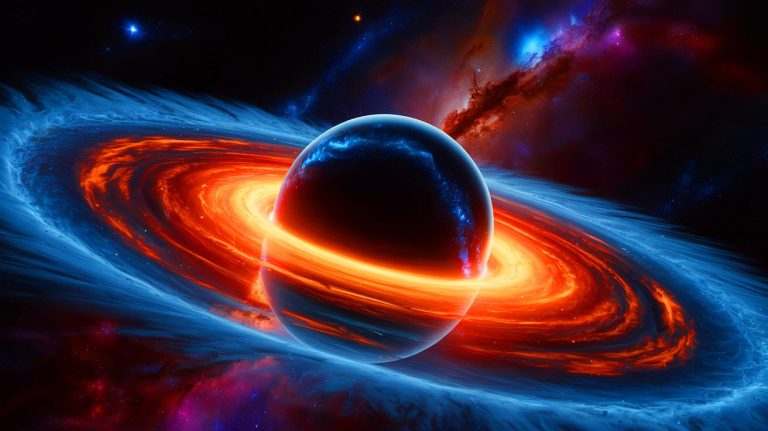| IN A NUTSHELL |
|
Black holes, often depicted as cosmic vacuum cleaners, have long captured the imagination of scientists and the public alike. These enigmatic entities, with their immense gravitational pull, challenge our understanding of the universe. Traditionally, black holes are defined by their singularities, points of infinite density where the laws of physics as we know them break down. However, recent advances in theoretical physics are reshaping this narrative, suggesting that black holes might not harbor singularities at all. This revelation could redefine our comprehension of these celestial objects and the universe’s fundamental principles.
The Enigma of Black Hole Singularities
In the realm of astrophysics, singularities represent a profound puzzle. According to Einstein’s theory of general relativity, when a massive star collapses under its own gravity, it forms a black hole with a central singularity. This point is characterized by infinite density and gravitational pull, where the fabric of space and time ceases to function as expected. However, the concept of infinity poses a significant challenge to physicists, as infinities do not fit within the established framework of physics. The presence of singularities signals a breakdown in the equations of general relativity under extreme conditions.
This conundrum has driven researchers to seek alternative models that can accurately describe black holes without invoking singularities. The quest for such models is not just a theoretical exercise; it has profound implications for our understanding of the universe and the fundamental laws governing it. Recent studies have brought new insights, proposing models that could potentially eliminate the need for singularities, thus offering a more coherent description of black holes.
Introducing Regular Black Holes and Mimickers
Among the new theoretical frameworks are regular black holes and black hole mimickers. Regular black holes are modified versions of traditional black holes. They retain most of the familiar structure but replace the central singularity with a core of finite density. This core may exhibit properties akin to “de Sitter” space, where gravity becomes repulsive rather than attractive, preventing total collapse. Consequently, these black holes trap matter and light for extended periods without the mathematical inconsistencies associated with singularities.
Black hole mimickers, in contrast, are hypothetical objects that resemble black holes but lack both an event horizon and a singularity. These entities do not permanently trap matter or light, allowing them to eventually escape. Mimickers have the potential to transform into regular black holes under certain conditions, offering a dynamic view of these cosmic phenomena. The idea that black holes and mimickers could transition into one another marks a significant departure from the traditional, static understanding of black holes.

Potential Implications for Physics and Astronomy
The introduction of these alternative models has far-reaching implications for both theoretical physics and observational astronomy. If proven valid, regular black holes and mimickers could resolve longstanding issues in black hole physics, providing a more accurate representation that aligns with known physical laws. This breakthrough would not only enhance our understanding of black holes but could also offer insights into other cosmic phenomena, such as the behavior of neutron stars and other compact objects.
Moreover, these models open new avenues for exploration, potentially guiding future astronomical observations and experiments. By eliminating the need for singularities, scientists can develop more precise predictions and test them against empirical data, thus advancing our knowledge of the universe. This ongoing research underscores the importance of questioning established theories and seeking innovative solutions to complex scientific problems.
The Road Ahead: Challenges and Opportunities
While the proposed models are promising, they remain theoretical constructs that require empirical validation. The challenge lies in obtaining observational evidence that can substantiate these hypotheses. Future research endeavors will need to focus on developing technologies and methodologies capable of detecting the subtle differences between traditional black holes, regular black holes, and mimickers. This endeavor will likely involve sophisticated simulations, advanced telescopes, and collaborative efforts across the scientific community.
As researchers continue to unravel the mysteries of black holes, the potential for groundbreaking discoveries remains vast. The pursuit of understanding these cosmic enigmas is a testament to human curiosity and the relentless drive to comprehend the universe. As we stand on the brink of a paradigm shift in black hole physics, one must ponder: what new mysteries and revelations await us in the depths of space?
Did you like it? 4.3/5 (22)










Wow, Einstein wrong? That’s a headline I never thought I’d see! 😲
Can someone explain what a black hole mimicker is in layman’s terms?
Thanks for the insightful article! Really made me rethink everything I thought I knew about black holes.
So, do these new models mean we can finally “see” inside a black hole? 🤔
I wonder how Einstein would feel about this. 😆
Great article! But how close are we to proving these new models?
Just when I was getting the hang of black holes, now there’s mimickers? Mind blown! 💥
Do these findings impact any other areas of physics outside of black holes?
Isn’t it a bit premature to say Einstein was wrong just based on theoretical models?
I’m a bit skeptical. How do we know these new models are correct without observation?